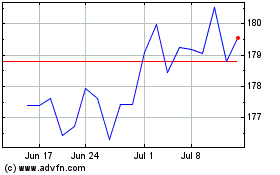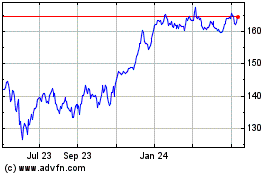By Sarah Krouse and Drew FitzGerald
Wireless carriers say the next generation of faster, 5G wireless
service will transform entertainment, communication and the
workplace. What they haven't said: how much it will cost.
Telecom giants like Verizon Communications Inc. and AT&T
Inc. are touting the ultrafast speeds that their in-home 5G
services will offer, and the first smartphones compatible with the
new networks are scheduled to hit the U.S. market this year. But
the carriers are still grappling with how they will charge
consumers and businesses for the service.
"I think it's going to be much more about evolution than
revolution," says Val Elbert, a partner focused on technology,
media and telecommunications at Boston Consulting Group.
Business are likely to begin paying for 5G networks as part of
their capital expenditures, probably opting to build faster,
private networks to power factories and stores, he says. The prices
consumers pay for mobile-phone plans are less likely to change
dramatically, he says, though some carriers may only offer 5G to
clients in the higher tiers of their unlimited data plans.
"I pay $160; I don't think tomorrow you can double that to $320"
for a monthly mobile family plan, even if speeds are significantly
faster, says Anthony Goonetilleke, who helps telecom companies with
their network buildout and pricing models as chief technology
officer of Amdocs, a provider of software and services to
communications and media companies.
Pricey upgrades
The cost of mobile wireless service has plummeted in recent
years, with consumers growing accustomed to lower bills and
unlimited data usage. U.S. mobile data cost roughly $3.33 a
gigabyte at the end of 2017, according to consulting firm Recon
Analytics, down from $11.12 a gigabyte three years earlier.
But upgrading networks to 5G standards requires billions of
dollars of fresh cash. Carriers must buy new radio equipment and
the infrastructure to support it, including fiber-optic lines and
hundreds of thousands of new small-cell installations --
investments they aim to recoup.
It is hard to separate 5G investments from the 4G upgrades that
companies would have made anyway. Many carriers will spend billions
of dollars on more-powerful 4G equipment that could become
5G-capable once new software is available.
Market analyst New Street Research predicts that Verizon alone
will spend an extra $20 billion over the next seven years to
support wireless broadband to the home, a 5G upgrade. But the
carrier and its competitors will need to spend billions more to
make 5G wireless coverage available nationwide. New Street Research
says Chinese network operators will devote more than $60 billion to
pure 5G upgrades in China over the next five years.
Carriers will need to generate added revenue to justify all of
that expense, but they haven't settled on how they will set
prices.
"Given the expected ecosystem around 5G, which includes things
like self-driving cars, augmented reality, telemedicine and
traditional handsets, there may well be plans and pricing outside
the traditional industry model," an AT&T spokesman says.
Mr. Goonetilleke says he expects 5G will usher in more bundled
services that combine hardware and on-the-go wireless connectivity
for products like virtual reality or gaming entertainment
systems.
"I think there's going to come a time when connectivity is going
to become ubiquitous. You're not going to think 'Am I outside?' or
'Am I in my car?' " he says.
Carriers are trying to position themselves to cash in on what
families pay for 5G phones, cable, entertainment and gaming, having
missed out on revenue generated by the apps and e-commerce
opportunities developed on the back of 4G networks.
Verizon currently sells a version of in-home 5G residential
broadband service for $70 a month. But that service is only
available in a handful of neighborhoods in areas such as Los
Angeles, Indianapolis and Houston, and it isn't based on the
international 5G standard set by a global industry trade group,
meaning the equipment eventually will need to be updated.
Diego Scotti, chief marketing officer at Verizon, says that in
the future, carriers may offer consumers different buckets of
service. That could mean 5G plans for mobile devices such as
smartphones, tablets and watches, for internet access in the home
or for both of those things -- mobile and in-home broadband --
together.
T-Mobile US Inc. said earlier this month that the additional
revenue from 5G was likely to come from new services, more
connected devices and business applications, rather than from
people upgrading their smartphone plans.
"We don't have plans for the smartphone plans that you see today
to charge differently for 5G enablement versus 4G LTE," says Mike
Sievert, the carrier's chief operating officer.
Sprint Corp.'s chief executive, Michel Combes, said on an
earnings call in January that its 5G service would be embedded in
some of the carrier's plans, adding that it should allow the
carrier to shift more customers to its high-end plans. He declined
to provide further details.
Shifting economics
Every new generation of networks comes with shifting economics,
but 5G is unique because it will be rolled out in a more fragmented
way than 4G. U.S. carriers are offering the new service piecemeal
to certain pockets of the country, typically dense urban areas. The
new networks require carriers to install more clusters of equipment
closer to consumers. Some of the airwaves they are using only
travel short distances, boosting carriers' capital costs.
To reap the full benefits of 5G, consumers must also buy new
mobile devices and change in-home equipment, such as routers. That
could lead to a longer adoption cycle than the change to 4G from
3G, some analysts say.
The rollout of 4G networks also coincided with the early years
of the smartphone, which allowed carriers to charge a premium.
Today, consumers are holding on to their devices longer, which
could delay their willingness to spend money on 5G-compatible
devices.
Some 42% of consumers were willing to pay between $10 and $20
more a month for 5G mobile broadband service, according to a survey
last year for Intel Corp. of 4,676 people in the U.S. and U.K. by
market-research firm Ovum.
Ms. Krouse and Mr. FitzGerald are reporters for The Wall Street
Journal in New York and Washington, respectively. They can be
reached at sarah.krouse@wsj.com and andrew.fitzgerald@wsj.com.
(END) Dow Jones Newswires
February 26, 2019 22:18 ET (03:18 GMT)
Copyright (c) 2019 Dow Jones & Company, Inc.
T Mobile US (NASDAQ:TMUS)
Historical Stock Chart
From Mar 2024 to Apr 2024

T Mobile US (NASDAQ:TMUS)
Historical Stock Chart
From Apr 2023 to Apr 2024
